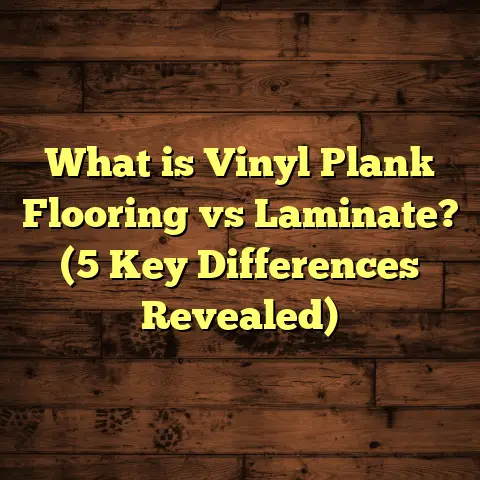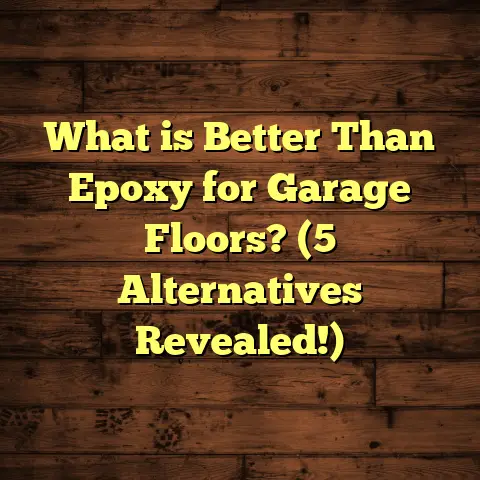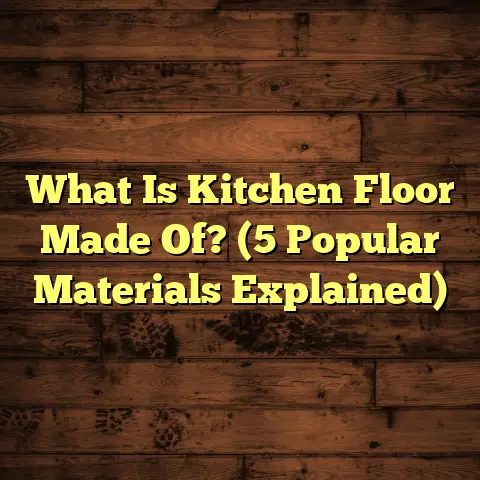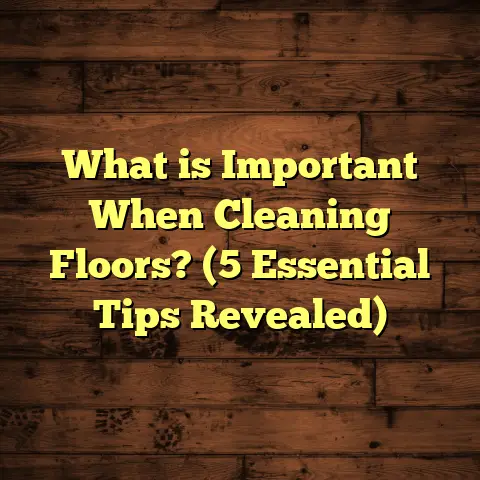What is Better Flooring: Laminate or Vinyl? (5 Key Comparisons!)
Imagine stepping into your home after a long day, the floor beneath your feet feeling just right—solid, warm, and welcoming. The look of the floor pulls your whole space together, reflecting your style and making your house truly feel like a home. Choosing the right flooring isn’t just about picking something that looks good; it’s about finding a base that supports your lifestyle and stands the test of time. Over the years, I’ve installed hundreds of floors, spent countless hours researching trends, and helped many homeowners decide between laminate and vinyl flooring. These two options often come up in conversation because they’re affordable, stylish, and practical—but which one is actually better for your unique situation? Let me walk you through everything I’ve learned, peppered with stories from the field and data-backed insights to help you make the best choice.
What Exactly Are Laminate and Vinyl Flooring?
Before we get into the side-by-side comparisons, let’s get clear on what these materials really are.
Laminate flooring is a multi-layer synthetic product primarily made of high-density fiberboard (HDF). On top of this core is a photographic layer that realistically mimics wood grain, stone, or tile patterns. The whole thing is sealed with a tough, clear wear layer that protects against scratches and stains. Over the years, laminate technology has improved dramatically. In the early 2000s, laminate flooring often looked fake or cheap, but today’s versions can be quite convincing.
Vinyl flooring, on the other hand, is made from polyvinyl chloride (PVC) and comes in sheets, planks, or tiles. The newer luxury vinyl planks (LVP) and luxury vinyl tiles (LVT) feature textured surfaces and photographic layers that also imitate natural materials. Vinyl is known for being extremely waterproof and flexible underfoot.
Both laminate and vinyl are designed as alternatives to hardwood or stone floors—offering similar looks without the high price or maintenance. But there’s much more to each material than meets the eye.
1. Durability: Which Flooring Can Handle Life’s Chaos?
Durability is probably the most common concern I hear from clients. “Will this hold up to my kids? My dog? The occasional spill?” It’s a fair question.
Laminate Durability
Laminate floors are tough because of their wear layer. This top coating protects against scratches from pets’ claws or furniture movement. Some premium laminates feature an aluminum oxide layer that makes them extra scratch-resistant—a big selling point for families with active children.
However, laminate has a significant weakness: moisture. Because the core is made of fiberboard, any water that seeps through seams or edges can cause swelling and warping. I’ve seen laminate floors buckle after plumbing leaks or pet accidents went unnoticed for too long.
In terms of impact resistance, laminate performs well under normal household use but isn’t great for heavy objects dropped repeatedly. I once worked on an office renovation where laminate flooring got chipped by falling tools—something vinyl probably would have taken better.
Vinyl Durability
Vinyl flooring excels at resisting moisture. It’s waterproof from top to bottom, so spills or humidity don’t cause damage. This makes vinyl perfect for kitchens, bathrooms, basements, laundry rooms—basically anywhere water is a concern.
Vinyl also resists stains and dents fairly well but can be vulnerable to sharp objects or heavy furniture dragging if not careful.
Interesting fact: A study by the Resilient Floor Covering Institute (RFCI) found that luxury vinyl flooring can last 20-30 years in residential settings with proper care—comparable to or exceeding laminate longevity in many cases.
Real-Life Example
I had a client who installed laminate in their mudroom thinking it’d be fine because it looked like wood and was affordable. After a few months of wiping off wet shoes and dog paws, the edges started swelling badly. They had to replace the whole floor with vinyl planks six months later—which held up perfectly afterward.
2. Installation: How Hard Will It Be to Get This Done?
If you enjoy DIY projects or want to save on installation costs, you’ll want flooring that’s easy to install without specialized tools.
Laminate Installation
Laminate flooring generally uses a click-lock system where planks snap together. You lay it as a floating floor over an underlayment that cushions sound and provides moisture protection.
The key challenge is ensuring the subfloor is flat and clean. Laminate doesn’t tolerate uneven surfaces well; bumps or dips can cause gaps or cracking over time.
I’ve coached many DIY clients who struggled getting planks aligned perfectly—especially around corners or doorways—but usually a bit of patience helps.
Vinyl Installation
Vinyl flooring can come in several forms:
- Sheet vinyl, which is rolled out in one piece and glued down.
- Luxury vinyl planks (LVP) and tiles (LVT) that either click together (floating) or have peel-and-stick adhesive backs.
Peel-and-stick vinyl is particularly beginner-friendly but only works well on very smooth surfaces.
Vinyl also tolerates minor subfloor imperfections better because it’s somewhat flexible.
Professional Installation Costs
Professional installers charge roughly $3-$8 per square foot for laminate and $2-$7 for vinyl depending on region and product quality.
Pro Tip
When installing vinyl in wet areas like bathrooms, I always recommend professional installation because seams need to be sealed properly to maintain waterproofing.
3. Appearance & Style: Which Flooring Looks More Realistic?
When it comes to aesthetics, both laminate and vinyl have come a long way.
Laminate Looks
High-quality laminate flooring often features embossed textures that mimic wood grain or stone surfaces. The photographic layer can replicate various wood species—from rustic oak to exotic maple—with impressive detail.
Because it’s denser than vinyl, laminate has a harder surface feel similar to real hardwood—which some people prefer.
However, laminate planks tend to be thinner than hardwood and have slightly sharper edges between boards.
Vinyl Looks
Luxury vinyl planks have textured surfaces designed to closely imitate wood grain patterns—including knots and grooves you can feel underfoot.
Vinyl offers more versatility in design: you can find stone-look tiles, concrete styles, even colorful patterns not possible with laminate.
Vinyl also tends to have a softer underfoot feel because it’s more flexible.
Personal Experience
I once installed both laminate and vinyl in a client’s open-concept home: laminate in the living room for warmth and vinyl in kitchen/bathrooms for durability. The client loved how each material suited its space visually and functionally.
4. Maintenance: What Does Daily Life Look Like?
Let’s talk about cleaning because no one wants a floor that demands a lot of upkeep.
Laminate Maintenance
Laminate floors require regular sweeping or vacuuming with soft bristles to prevent scratches from grit.
Spills should be wiped immediately since standing water can damage the fiberboard core underneath.
Avoid wet mopping; instead use slightly damp cloths with cleaner designed specifically for laminate (no waxes or polishes).
Vinyl Maintenance
Vinyl is more forgiving: it handles wet mopping well and doesn’t stain easily.
You can use mild detergents or commercial vinyl cleaners without worry.
Vinyl also tends to hide dirt better thanks to its textured surface.
5. Cost: Which Flooring Fits Your Wallet?
Cost can make or break a project budget. Here’s how laminate vs vinyl stack up:
- Laminate flooring material: $1 – $5 per square foot.
- Vinyl flooring material: $2 – $7 per square foot.
- Installation: Laminate $3 – $8/sq ft; Vinyl $2 – $7/sq ft.
Overall, laminate tends to be cheaper upfront but may require replacement sooner if exposed to moisture damage.
I worked on a project where the client initially wanted hardwood for an entire home but switched to vinyl in wet areas after seeing budget projections. This saved them thousands while still offering elegant aesthetics.
6. Comfort & Sound: How Does It Feel Underfoot?
A detail often overlooked is how flooring feels when you stand or walk on it for long periods.
Laminate Comfort
Laminate has a firm feel due to its dense core; it doesn’t compress much underfoot. This firmness gives it an authentic hardwood feel but can be less forgiving on joints if you stand a lot in one spot (like kitchen work areas).
Some people add cushioned underlayment for more comfort and sound absorption.
Vinyl Comfort
Vinyl is softer and more resilient due to its plastic makeup. It has a slight give that can make standing easier on knees and feet over time.
Sound-wise, laminate can sometimes produce a hollow “click” sound when walked on without proper underlayment. Vinyl tends to be quieter naturally because of its flexibility.
7. Environmental Impact: Which Flooring Is Greener?
Sustainability matters more now than ever before when choosing materials for your home.
Laminate Environmental Considerations
Laminate uses engineered wood products which come from wood fibers bonded with resins—some of which may emit volatile organic compounds (VOCs) initially but typically meet strict indoor air quality standards today.
Recycling options are limited; laminate isn’t biodegradable due to its composite layers.
Vinyl Environmental Considerations
Vinyl production involves PVC plastics derived from petrochemicals. This raises concerns about environmental footprint and potential chemical off-gassing during installation.
However, many manufacturers now produce low-VOC certified products with recycled content.
8. Resale Value: Will Your Flooring Choice Affect Home Value?
If you plan to sell your house someday, flooring type can influence buyer perceptions.
Generally:
- Hardwood floors boost resale value the most.
- Laminate mimics hardwood but some buyers see it as “cheap” compared to real wood.
- High-end luxury vinyl has improved reputation but still lags behind hardwood visually for resale.
- Vinyl’s durability in kitchens/bathrooms may appeal to buyers focused on maintenance ease.
In my experience listing homes for clients, properties with well-maintained hardwood or high-quality laminate floors tend to attract higher offers than those with basic vinyl flooring—but location and overall condition matter far more than just floor type.
9. Common Myths About Laminate & Vinyl Floors
I often hear misconceptions from clients which can cloud their decisions:
- Myth: Laminate is waterproof — False! It resists spills but water damage is a risk.
- Myth: Vinyl looks cheap — Not anymore! Luxury vinyl looks very realistic.
- Myth: Laminate feels plasticy — Good quality laminate feels quite like wood.
- Myth: Vinyl smells bad — Newer low-VOC products have minimal odors.
- Myth: Only pros can install these floors — Many DIYers successfully install both with patience.
Final Thoughts: Which One Should You Pick?
After walking through all this info—durability, installation ease, style options, maintenance needs, cost considerations, comfort level, environmental impact, resale value—it boils down to your personal priorities:
| Factor | Laminate | Vinyl |
|---|---|---|
| Durability | Scratch-resistant but moisture-sensitive | Waterproof & flexible |
| Installation | Precise subfloor needed | More forgiving & DIY friendly |
| Appearance | Hard surface feel & realistic wood | Versatile designs & soft feel |
| Maintenance | Dry cleaning preferred | Wet mopping okay |
| Cost | Generally cheaper upfront | Slightly higher but durable |
| Comfort | Firm underfoot | Softer & quieter |
| Environmental | Engineered wood product | Plastic-based with low-VOC options |
| Resale Value | Good but less than hardwood | Practical appeal |
Here’s my advice from years of hands-on work:
- For living rooms, bedrooms, hallways where dryness is guaranteed: laminate delivers great looks at a great price.
- For kitchens, bathrooms, basements prone to moisture: vinyl keeps you worry-free without sacrificing style.
- If you want a mixed-material approach (and many do), go ahead! Use each where it fits best.
Flooring choices shape your living space every day—they deserve thoughtfulness beyond just price tags or trends. I hope sharing my experience helps you walk confidently toward the perfect floor for your home’s story.
Have any questions about specific brands, installation tips, or care routines? I’m here to help!





